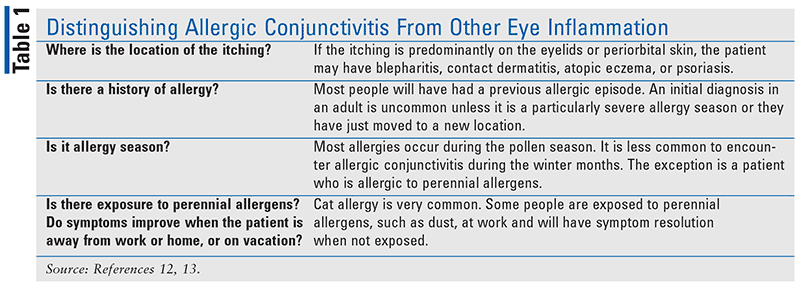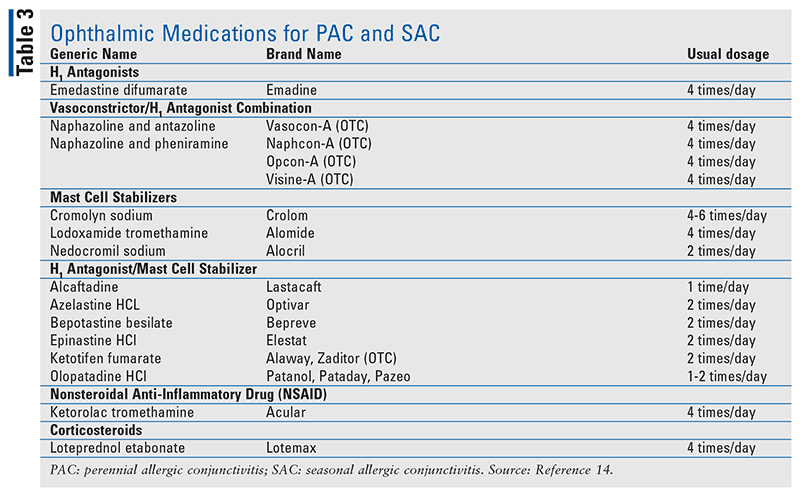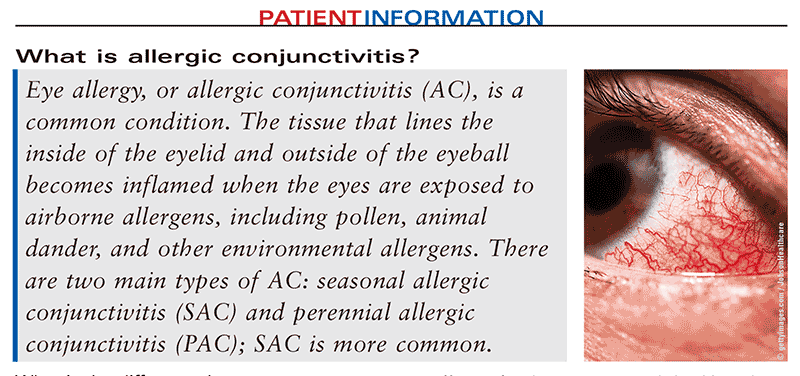US Pharm.2019;44(5)8-12.
The prevalence of allergic disease has increased over the past few decades, with more than 50 million Americans suffering from some type of allergy.1 Ocular allergies are among the most frequently encountered ophthalmic conditions. The ocular conjunctiva is a mucosal surface that is constantly accessible to airborne allergens. It is also a common site for allergic inflammation. A commonly encountered ocular allergy is allergic conjunctivitis (AC), affecting up to 30% of the general population. In patients who suffer from allergic rhinitis, ocular symptoms are present in up to 70%.2 AC, which peaks in late childhood and young adulthood, is also the most prevalent ocular condition encountered by pediatric healthcare providers, affecting approximately 30% of children.2,3 Although very common, AC is often overlooked or undertreated, especially in the pediatric population.4 While thought of as just “itchy eyes,” many patients who suffer from allergic conjunctivitis may experience a decreased quality of life, with symptoms affecting many aspects of their daily activities.5,6
As patients become more engaged in their own healthcare, the pharmacist is increasingly becoming the first healthcare professional encountered, especially when discussing conditions that have nonprescription medications available for treatment or symptom relief. Pharmacists are the intermediary between the patient and physician, recognizing when symptoms may be indicative of a more serious condition, warranting a referral. Allergic conjunctivitis represents one of those conditions that pharmacists are going to frequently encounter.
Allergic Conjunctivitis
AC is an inflammatory response resulting from exposure of the ocular conjunctiva to airborne allergens, including pollen, animal dander, and other environmental allergens.7 The term is used to describe a variety of ocular allergies. Seasonal allergic conjunctivitis (SAC) and perennial allergic conjunctivitis (PAC) are the two most common forms of AC, representing more than 95% of ocular allergies; of the two, SAC is more prevalent.8,9 These are both associated with an immunoglobulin E–mediated hypersensitivity reaction. The more severe chronic forms of AC include vernal keratoconjunctivitis (VKC) and atopic keratoconjunctivitis (AKC), which are both mast cell–mediated allergic conditions.4,10 Despite some common allergy markers, AKC and VKC have clinical and pathophysiologic features that are different from PAC and SAC. They occur less frequently but are potentially more severe and sight-threatening, necessitating referral to an eye specialist.11
Clinical Presentation
Signs and symptoms of SAC and PAC are the same, but they differ in the onset and duration of symptoms, and specific allergen to which the patient is sensitive. Seasonal allergies are triggered by circulating aeroallergens such as tree, grass, and weed pollens. Symptoms will fluctuate throughout the year, commonly causing exacerbations during times of high pollen counts, such as spring and summer, and during windy and dry weather conditions. Patients who have PAC will experience symptoms that persist throughout the year, owing to continuous exposure to perennial allergens commonly including dust mites, animal dander, and feathers.4,10 Many patients who have PAC—almost 79%will also experience a seasonal exacerbation.11
Patients will typically present with bilateral eye symptoms, including red, itchy, and watery eyes; pruritus is considered the hallmark symptom. The itch may be more aggravating in the nasal quadrant of the eye, ranging from mild to severe. The discharge is usually watery but may contain a small amount of mucus. There may also be some mild chemosis, or conjunctival swelling, associated with AC. This prominent swelling and mild redness often gives the conjunctiva a pinkish or milky appearance. Lid edema may also sometimes occur. Although symptoms are usually bilateral, the degree of involvement may not always be symmetrical.3,10-12
When evaluating a patient with ocular complaints, it is important to recognize when a referral is necessary. Some useful questions can help the pharmacist distinguish AC from other possible causes (Table 1). If the patient does not complain of itch, a diagnosis of AC is highly unlikely. However, if a patient is complaining about severe itching, this could be indicative of VKC or AKC, which should prompt a referral. Patients who should immediately be referred to a specialist include those who use contact lenses; those who have experienced trauma to the eye; those with any sign of vision changes including the onset of floaters and diplopia; those who experience severe ocular pain and/or sensitivity to light; and those who are also experiencing any systemic symptoms along with their ocular complaints.4,12,13
Treatment
When treating patients suffering from SAC and PAC, goals of therapy include avoidance of allergens, reduction in severity and symptoms, and improvement in quality of life.4 Appropriate management should result in immediate relief and control of symptoms. Based on symptomatology, patients should be treated in a stepwise approach (Table 2).4 Patients should be questioned in order to identify ocular allergens and educated on how to avoid them. Allergen avoidance measures include checking the pollen count and staying inside when it is high, keeping windows closed, turning on the air conditioning, wearing sunglasses outdoors as a barrier to airborne allergens, avoiding eye rubbing, and using air filters. Application of cold compresses to the eyes 3 to 4 times per day, using hypoallergenic bedding, and bathing/showering before bedtime may also alleviate symptoms of redness and itchiness. Application of refrigerated artificial tears may also provide relief; artificial tears provide a barrier and help improve first-line defense by diluting allergens and inflammatory mediators that may be present on the ocular surface.10,14
If nonpharmacologic measures do not offer adequate relief, pharmacologic agents can be utilized. Pharmacologic treatments include the use of topical antihistamine/vasoconstrictor combination products, mast cell stabilizers, antihistamines with mast cell stabilizing properties, nonsteroidal anti-inflammatory agents, and corticosteroids (Table 3).
Topical Antihistamine/Vasoconstrictor Combination Products
Topical decongestants were the first agents approved for the treatment of AC with the discovery of tetrahydrozoline in the 1950s and the approval of the first agent, naphazoline, in 1971. Today they are still one of the most common OTC agents used in the management of AC in the absence of medical consultation. Topical decongestants are effective in alleviating hyperemia but have little to no effect on ocular itching. As such, ocular decongestants were paired with topical antihistamines such as pheniramine and antazoline to help relieve both the itching and redness. Topical antihistamines block histamine receptors, relieving ocular itching. The combination of an antihistamine with a vasoconstrictor has been shown to be more effective than either agent alone. These topical medications are appropriate for short-term (not more than 10 days) or episodic use only. Regular use has been associated with tachyphylaxis and should not be routinely recommended. Other adverse effects include burning and stinging upon instillation, and mydriasis. In addition, their duration of action is short, requiring frequent administration.4,7,11,15,16
Mast Cell Stabilizers
Although the full mechanism of mast cell stabilizers is not entirely understood, it is believed that they prevent the degranulation of mast cells and prevent the release of preformed inflammatory mediators, providing relief by preventing both the early and late-phase allergic response. However, these agents have a slow onset of action, requiring up to 14 days to reach maximal efficacy. They are more effective in preventing symptoms and should therefore be used prophylactically. This class may provide an option for patients who do not tolerate other therapies. Treatment should begin 2 to 4 weeks prior to the start of the allergy season. Topical mast cell stabilizers have minimal ocular side effects, with burning and stinging being the most common effects.7,10,15
Antihistamines With Mast Cell Stabilizing Properties
This dual-acting class of medications is now considered the mainstay of treatment for PAC and SAC. These agents combine the actions of competitively and reversibly blocking histamine receptors in the conjunctiva and eyelids and inhibiting mast cell degranulation. Unlike mast cell stabilizers, these agents provide immediate and sustained relief. Olopatadine has proven superiority when compared with most other agents used in the control of ocular allergy symptoms. These agents are generally well tolerated and can be used in the long-term treatment of SAC and PAC. The most commonly reported side effects include headache, burning, stinging, and bitter taste.7,10,15
Nonsteroidal Anti-Inflammatory Agents
Nonsteroidal anti-inflammatory drugs (NSAID) inhibit prostaglandin and leukotriene production. These agents are typically used as short-term additive therapy. Topical NSAIDs reduce ocular itch and conjunctival hyperemia associated with SAC. Ketorolac is the only approved topical NSAID for the treatment of SAC.7,10,15
Corticosteroids
Topical corticosteroids are the most potent pharmacologic agents used in the management of ocular allergies. Their use should be reserved for patients experiencing refractory symptoms not controlled by antihistamines with mast cell stabilizing properties. Their efficacy is attributed to their ability to inhibit prostaglandin and leukotriene synthesis, but their ocular side effects can be vision-threatening. Treatment should be limited to 2 weeks, and patients should be monitored for exacerbations of conjunctival or corneal viral infections and for increased intraocular pressure. However, these adverse effects have become less worrisome since the development of “soft” steroids, such as loteprednol. These agents greatly reduce the risk of causing increased intraocular pressure and cataract formation due to their rapid metabolism and inactivation upon penetration of the cornea.
Intranasal corticosteroids have also been evaluated in the management of ocular allergic symptoms in patients with allergic rhinitis. Favorable effects have been seen with mometasone furoate, fluticasone furoate, fluticasone propionate, and budesonide.4,7,10,15,16
CONCLUSION
SAC and PAC are common diseases. These are conditions that can significantly impact a patient’s quality of life and productivity. Pharmacists play an integral role in the management of AC; they can have a major impact by identifying patients who are self-medicating and educate on them on proper management of AC. Management strategies should include the combination of allergen avoidance and pharmacotherapy. Treatment should be individualized based on the frequency and severity of bothersome symptoms. It is always best to use the shortest course of therapy and to step treatment down to the lowest effective dose that will provide optimal symptom relief. Pharmacists also need to be able to quickly recognize patients who require immediate referral to an eye specialist. With appropriate questioning and education, pharmacists can aid the patient in achieving optimum symptom control.
What is the difference between SAC and PAC?
SAC usually causes symptoms during a particular season, like in the spring and summer, and during windy and dry weather conditions. Symptoms can vary throughout the year depending on pollen count. Seasonal allergens include tree, grass, and weed pollens. People who suffer from PAC will experience symptoms all year round since they can have continuous exposure to allergens such as dust mites, animal dander, and mold.
What are the symptoms of AC?
People suffering from AC will typically experience redness and itching of both eyes. Watery discharge from the eyes is common but it may also contain a small amount of mucus. Eyes may also have a pinkish or milky appearance, and eyelids may be swollen. Rubbing can worsen the symptoms.
What can help?
Allergen Avoidance: Allergen avoidance measures include checking the pollen count (there’s an app for that) and staying inside when it is high, keeping windows closed, turning on the air conditioning, wearing sunglasses outdoors as a barrier, avoiding eye rubbing, and using air filters. Other measures include cold compresses to the eyes 3 to 4 times a day, using hypoallergenic bedding, and bathing/showering before bedtime to help relieve symptoms of redness and itchiness. Using artificial tears can help wash away the allergens.
Medications: Many types of eye drops can be used to help reduce symptoms. An antihistamine/vasoconstrictor combination product (e.g., Naphcon-A) is effective for short-term use and should not be used for more than 10 days. These types of drops are available OTC. Antihistamine/mast cell stabilizer combination products (e.g., Patanol) are well tolerated and provide immediate and sustained relief. Most of these products require a prescription, but ketotifen is available without a prescription. Mast cell stabilizers (e.g., Crolom) have a slow onset of action and should be started 2 to 4 weeks before allergy season to prevent symptoms. Steroid eye drops should only be used short-term and in those people still experiencing symptoms after trying other products. An oral antihistamine can be used but is most helpful when taken to prevent symptoms. If symptoms have already started, it may take a few days to see the benefit. Speak with your pharmacist, who will guide you in choosing the proper product.
When should I see an eye specialist?
If you have symptoms such as severe itching, vision changes, eye pain, sensitivity to light, and systemic side effects (e.g., fever), it is best to see an ophthalmologist right away. You should also see an eye-care specialist immediately if you have a history of trauma to your eye or if you wear contact lenses. Your pharmacist can help you identify your symptoms and know when to refer you to your doctor.
REFERENCES
1. CDC. Allergies. Gateway to health communication. www.cdc.gov/healthcommunication/toolstemplates/entertainmented/tips/Allergies.html. Accessed April 10, 2018.
2. Leonardi A, Castegnaro A, Valerio AL, Lazzarini D. Epidemiology of allergic conjunctivitis: clinical appearance and treatment patterns in a population-based study. Curr Opin Allergy Clin Immunol. 2015;15(5):482-488.
3. Berger WE, Granet DB, Kabat AG. Diagnosis and management of allergic conjunctivitis in pediatric patients. Allergy Asthma Proc. 2017;38(1):16-27.
4. Bielory L, Meltzer EO, Nichols KK, et al. An algorithm for the management of allergic conjunctivitis. Allergy Asthma Proc. 2013;34(5):408-420.
5. Buchholz PM, Walt J, Lorenz D, et al. Patient impact of allergic conjunctivitis as measured by the Eye Allergy Patient Impact Questionnaire (EAPIQ). Invest Ophthalmol Vis Sci. 2003;44(13):3735.
6. Pitt AD, Smith AF, Lindsell L, et al. Economic and quality-of-life impact of seasonal allergic conjunctivitis in Oxfordshire. Ophthalmic Epidemiol. 2004;11(1):17-33.
7. Bielory BP, O’Brien TP, Bielory L. Management of seasonal allergic conjunctivitis: guide to therapy. Acta Ophthalmol. 2012;90(5):399-407.
8. Butrus S, Portela R. Ocular allergy: diagnosis and treatment. Ophthalmol Clin North Am. 2005;18(4):485-492.
9. Bielory L, Friedlaender MH. Allergic conjunctivitis. Immunol Allergy Clin North Am. 2008;28(1):43-58.
10. La Rosa M, Lionetti E, Reibaldi M, et al. Allergic conjunctivitis: a comprehensive review of the literature. Ital J Pediatr. 2013;39:18.
11. Bielory L. Allergic and immunologic disorders of the eye. Part II: ocular allergy. J Allergy Clin Immunol. 2000;106(6):1019-1032.
12. Friedlaender MH. Ocular allergy. Curr Opin Allergy Clin Immunol. 2011;11(5):477-482.
13. Galor A, Jeng BH. Red eye for the internist: when to treat, when to refer. Cleve Clin J Med. 2008;75(2):137-144.
14. American Academy of Ophthalmology. Conjunctivitis PPP - 2018. Published November 13, 2018. www.aao.org/preferred-practice-pattern/conjunctivitis-ppp-2018. Accessed March 18, 2019.
15. Ackerman S, Smith LM, Gomes PJ. Ocular itch associated with allergic conjunctivitis: latest evidence and clinical management. Ther Adv Chronic Dis. 2016;7(1):52-67.
16. Abelson MB, Shetty S, Korchak M, et al. Advances in pharmacotherapy for allergic conjunctivitis. Expert Opin Pharmacother. 2015;16(8):1219-1231.
To comment on this article, contact rdavidson@uspharmacist.com.









